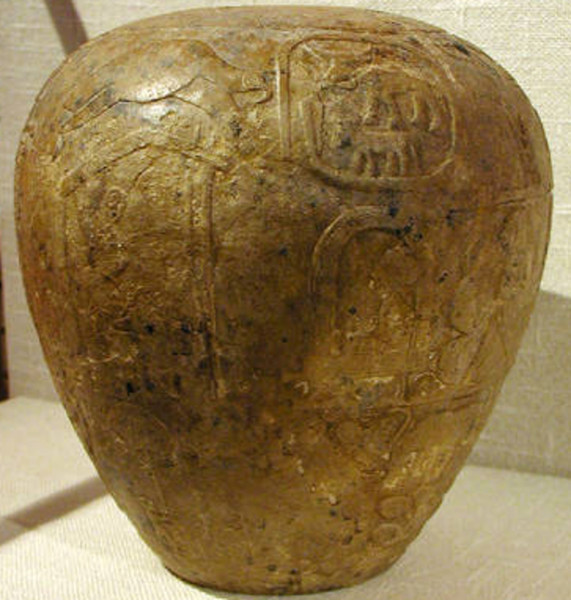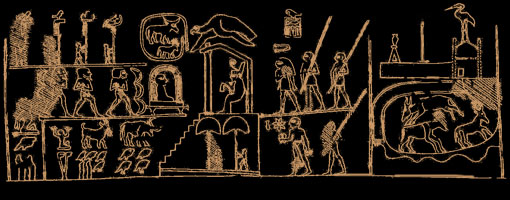The Narmer Macehead was found in the so called “main deposit” of the temple of Nekhen (Hierakonpolis), along with the Narmer Palette and the Scorpion Macehead. The Narmer Macehead dates to the Early Dynastic Period (the end of Dynasty 0 or the beginning of Dynasty 1), the period of the unification of Upper and Lower Egypt. The meaning of the images depicted on it are the subject of a great deal of speculation.

In the middle of the scene sits Narmer on a throne on a raised platform under a canopy. He wears the red crown (deshret) of Lower Egypt and carries the royal flail. Two fan or sunshade bearers stand beneath the platform and behind him stand three men holding long staves (possibly his royal guard), a man with the hieroglyph of a tether above his head (who may be a priest or the vizier if this title existed at this early time) and another with a club followed by a rosette identifying him as the servant of the king.
Facing Narmer there is a person sitting in a litter. Schott proposes that this person may be one of the children of the pharaoh and Millet has further suggested that it may be his daughter, as female children were often present at important ceremonies throughout Ancient Egyptian history. However, Wilkinson (1999) has suggested the figure may be a god and Petrie (1939) believed the figure was Narmer’s bride. Above the litter there is a small enclosure with a cow and calf within it. Behind this man are three bearded men who are depicted as running towards the king. Helck (1987) suggested that these figures are bound but Millet (1990) does not agree with this assertion.

Above the runners stand four men bearing tall standards who probably represent the “followers of Horus” based on their similarity to standard bearers from a fragment found in the Sun Temple of Niuserre (Borchardt and von Bissing 1923). Below the runners there are depictions of cattle, men, and goats along with a series of numbers. The meaning of these numbers has been debated and rather depends on the meaning ascribed to the rest of the scene but they could be a record of the number of animals and people captured in battle or presented during the ritual or wedding.
On the right hand side there is a temple enclosure with a pot on a stand, a standard (the top of which is missing), and a bird (suggested by Schott to be a heron) on a tall pole. This is probably a marker of the location of the scene (Millet, Schott). In the oval enclosure there are three antelope and symbols indicating that the shrine is located in “a desert landscape beside a watercourse” (Millet). Millet and Schott both suggest that the shrine depicted is the shrine at Buto (because of the Heron), but Friedman has rather speculatively proposed that the enclosure is the predynastic temple located in the desert outside Nekhen (Hierakonpolis).
Petrie (1939: 79) concluded that the scene commemorated the marriage of Narmer to Neithhotep, a princess of Lower Egypt, to enable him to consolidate his power on the two lands following his military victory. However, inscriptions at Wadi Ameyra in Sinai may suggest that Neithhotep was instead the mother and co-regent of Djer, making her the wife of Hor Aha.
It is also proposed that the scene may depict the Sed festival of Narmer (Cialowicz 2001: 257, Vandier 1952: 602-605). Millet notes that the king is not seated in the typical Sed platform with the dual stairs and dual thrones to represent Upper and Lower Egypt, although this format may not have been in use in this early stage. Nonetheless, Millet suggests that it may be the festival known as “the Appearance of the King of Lower Egypt”. The Palermo Stone first mentions this festival later in the first dynasty (on the third line) but the corresponding festival of “the Appearance of the King of Upper Egypt” does have an earlier mention. There was also a festival named “the Appearance of the King of Upper and Lower Egypt” which is mentioned in the Palermo Stone.
A tablet from later in the first dynasty depicts the Pharaoh Den celebrating this festival and in one scene he sits on a single throne under a canopy much like that of the Narmer Macehead. However, it should also be considered that much of the Macehead is missing and it has also been proposed that there may once have been a similar scene depicting Narmer wearing the white crown (hedjet) of Upper Egypt.
Millet (1990) also proposed that the scenes were not in fact commemorative of a specific event, but rather that they were depictions of a specific year (in a manner reminiscent of the details recorded on the Palermo Stone) and were intended to confirm the date that the macehead was presented to the temple. Millet notes that the second dynasty Pharaoh Khasekhemwy also presented a gift to the temple which he dated with the inscription “Year of Uniting the Two Lands; Fighting and Smiting the Northerners” and he suggests that the numbers by the depictions of cattle etc. in the bottom left corner are in fact a census rather than a record of booty or a dowry.
- Bard, Kathryn (2008) An introduction to the Archaeology of Ancient Egypt
- Clayton, Peter A (1994) Chronicle of the Pharaohs
- Dodson, A and Hilton, D. (2004) The Complete Royal Families of Ancient Egypt
- Kemp, Barry J (1991) Ancient Egypt: Anatomy of a Civilisation
- Millet, N. B. (1990) “The Narmer Macehead and Related Objects” from Journal of the American Research Center in Egypt Vol. 28 pp. 53-59
- Smith, H.S. (1992) The Making of Egypt
- Wilkinson, Toby A H (1999) Early Dynastic Egypt
- Wilkinson, Toby A H (2000) “What a King Is This: Narmer and the Concept of the Ruler” from The Journal of Egyptian Archaeology
- Wilson, Hilary (1997) People of the Pharaohs
Copyright J Hill 2010